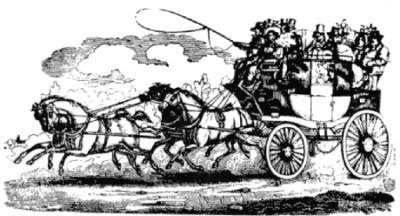
Over Sands Coach Service
The religious orders first established the guides "over the sands". They also established chantry chapels near the ends of the crossings, e.g. at Hest Bank, Silverdale, and on Chapel Island in the Leven estuary.
The soldiers of Robert Bruce crossed the sands in their invasion of Lancashire in 1322. To quote from the Lanercost Chronicle - "They went further beyond the sands of Leven to Cartmel, taking away cattle and spoil, and so they crossed the sands of Kent as far as the town of Lancaster which they burnt, except for the Priory of the Black Monks and the homes of the preaching Friars."
In 1487 Lambert Simnel, "Pretender" to Henry VIIth's throne, landed at Piel, near to present day Barrow, from Dublin, where he had been "crowned" king. His supporters, consisting in the main of Irishmen and Germans, moved inland, crossed the sands, and eventually reached York. He was defeated in a battle fought near Newark.
George Fox, founder of the Society of Friends (Quakers) was arrested in 1660 at the Swarthmoor Hall, near Ulverston. He was conducted across the Sands by a troop of horse (30 men) for trial and imprisonment in Lancaster Castle.
John Wesley reached the shore at Hest Bank in 1759 and in his Journal describes how he crossed the sands on horseback "racing the tide". Many of the earliest travellers to the Lake District from the end of the eighteenth century onwards used the cross sands route.
Until the arrival of the railways, there was a scheduled "over sands" coach service between Ulverston and Lancaster. Today, the only remaining vehicles using the sands are the carts belonging to the fishing and shrimping fraternities.
DUTIES OF THE GUIDE
The "office of the Carter" was to go on his white horse (the better to be seen in the mist and semi-darkness), to the river channel as soon as the tide had ebbed. He stuck birch branches or pieces of broom deeply in to the sand, with little of the tops exposed, to mark his trail. This method is still used by local fishermen when they go out on to the sands to gather cockles or to tend their nets. It is called "brodding" or "brobbing". The twigs are light to carry and are not easily silted over.
On arriving at the channel of the Kent the guide tested the depth of the water, and the firmness of the bottom, with the long pole which he carried. Having found a suitable fording place he blew a blast on a horn to inform any travellers. He would then remain in this position until the tide rose high enough to make further crossings impossible, when he would sound his horn again and withdraw. The guide had a pillion behind his saddle on which "respectable ladies and others" passed over the estuary before the days of public transport.
The Queens Guide, Cedric Robinson, was recently given an MBE in recognition of his work as The Queens Guide to the Sands for many years.
Details of cross bay walks are available from the Guide on 015395 32165
UK SEO by bf internet
|



























